Timothy, the publisher, moderator, and all around mensch of Catholic Bible Talk’s predecessor Catholic Bibles Blog has done more than anyone I know in this post-Liturgiam Authenticum world of defending dynamic equivalency as an acceptable way of translating the sacred text. It was my interest in the Knox Bible that brought me to his blog back around 2013 or 2014 and while I never fell in love with The Message, I always read his comments on that vigorous paraphrase with great interest.
For that reason, my interest was piqued a few years back when I was trying to find a used copy of the Knox on Amazon and saw one with the description “ex-Library of Eugene H. Peterson, with signature on flyleaf. Some minor markings next so some verses” (sic). Was this Eugene Peterson who paraphrased the Message? (As a side note, the deuterocanonical books were paraphrased by William Griffin when those were added to the text to create a Catholic edition.)
I already owned a copy of the Knox—it is just that the Baronius edition is too nice for me to toss into a backpack. I didn’t feel like spending 40 dollars on a bible translation I already owned and forgot all about that bizarre listing for a while. A conversation with Timothy a year or so later reminded me of that Peterson/Knox connection, but when I looked at Amazon, I couldn’t find the listing. No matter, I thought. Decent copies of the Knox move quickly on the secondary market. It must have been snapped up.
The innovative nature of the Knox—the departure from the Douay-Rheims, the text in paragraphs, the verse numbers in the side-column, a vigorous and classic English style—attracted a diversity of formats in the translation’s brief flowering, so lovers of the Knox might well note that the single edition printed by Baronius is wonderful, but not the only one. Those, like me, who sometimes find the Baronius edition’s single column text block a bit too wide for the eyes ought to look to the older editions. Whereas Baronius’s edition has a text block of about 81 characters, my Sheed and Ward copy of the Old Testament (in two volumes) and New Testament (in a third) has a text block of around 68 characters. A difference of 13 characters seems awful insignificant in the abstract, but it makes a huge difference in ease on the eyes. When the entire bible was released between two covers the editions moved to a double column layout, but in a completely different direction keep an eye out for the Chanticleer edition of the New Testament with beautiful illustrations, drop caps to die for, and the footnotes in a side column instead of at the foot of the page. There are also an abridged Old Testament (entitled “The Shorter Knox Bible”), standalone editions of the Psalter (in both its Gallican and New Latin text editions), and “The Gospel Story”, a Knox-Cox collaboration which harmonized the Gospels and traded in thee and thou for the modern equivalent. In an era where the verse-by-verse, two column text was still the norm, formats of the Knox were an embarrassment of riches. These editions, and more, might keep a lover of that translation looking at Ebay and Amazon a few times a year.
And that was exactly what I was doing when the listing reappeared, on the online store of a bookdealer out of Springfield, Missouri. It was listed as “very good”. The price had gone down. I had extra money from my second job and wasn’t yet aware that the world economy was about to succumb to COVID-19. I pulled the trigger. Even if Marc and Timothy are the only ones who read this, I thought I might share this odd item with this blog’s wonderful readers.
It is a Sheed and Ward edition from the 1956, judging by the used market one of the most popular of the Knox editions in America. The text is in two columns with verse numbers in the side column and single column annotations in the footer. It fits comfortably in the hand and was printed in several editions which are almost identical as far as I can see: Family Edition, Student editions, and perhaps more. This one is a cloth hardback, though I’ve seen other hardbacks that seem much more glossy than cloth. The binding is sewn. To be frank, I’ve never seen a Knox edition without a sewn binding, even a mass market paperback of “The Letters of St. Paul” seems to have visible signatures! Catholic bibles sure have changed—and not for the better!
The bookplate features a quote from poet TS Eliot, Anglican theologian Austin Farrer, and the RSV text of Ezekiel 3:3.
On the endpaper opposite the bookplate is his signature and what seems to be the date November 25, 1961 (which happens to be my birthday, albeit more than two decades early). Peterson had been ordained in the Presbyterian Church in 1958 after time in the New York Theological Seminary and John Hopkins University. He returned to the New York Theological Seminary to teach in 1959 and 1960, and if this is truly Eugene Peterson’s bible (well, one of them), he bought it while he was the associate pastor of a church in White Plains, New York. The next year he would found Christ Our King Presbyterian Church in Bel Air, Maryland which would be his base for the next 29 years. It was only after his retirement there that he was able to finish work on The Message.
In pencil, Peterson underlined several interesting passages from Cardinal Bernard Griffin’s preface to the Knox Bible. The first is Jerome’s famous quote that, “to be ignorant of the Scripture is not to know Christ.” Further down the page he underlines the Cardinal’s opinion that “Bible reading is not to be regarded as the prerogative of specialists”, a quote that may as well be taken as a cri de couer of the entire Message project.
How many used books have you read that were highly annotated for about a chapter and a half but with no proof that the reader got past page 25? Well, this is one of those books!
Whoever it is who took the notes (whether Peterson or another) was very keen on underlining each iteration of “God said” in the introduction to the days of the Creation, as well as marking off the days with roman numerals.
After that VII alongside the start of Genesis, Chapter 2, the notetaking ends. If that wasn’t enough to show this was not a book that was read often or at all, through a manufacturing error two pages in the Prophets were entirely connected on their fore edge, making it impossible to read in that place until I liberated it with a razor blade.
Were these notes made by Peterson himself? Peterson died in Lakeside, Montana. It is conceivable that the book made it from there to Springfield, Missouri, and it does not seem like this was a book that passed through many hands. It will be a curio on my shelf for sure, though I’m likely to read it more than he did.
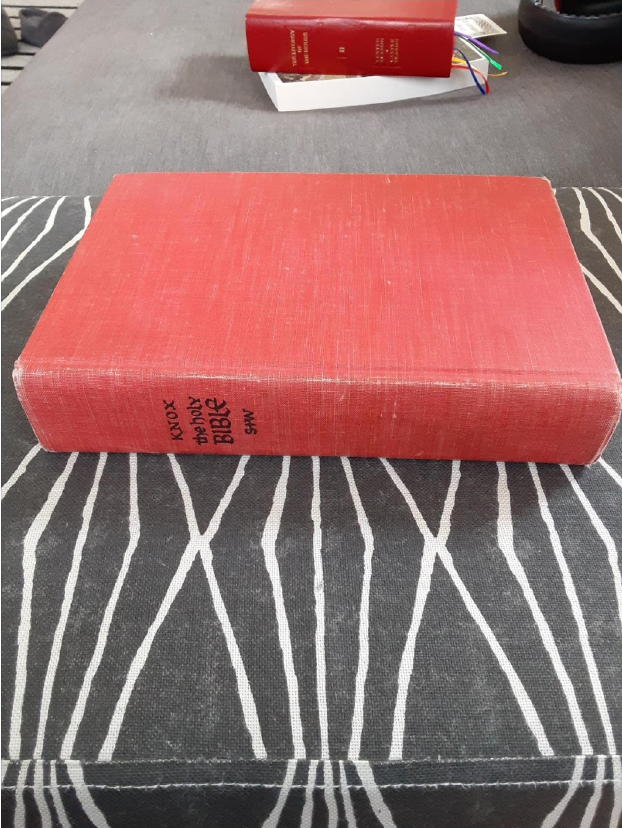
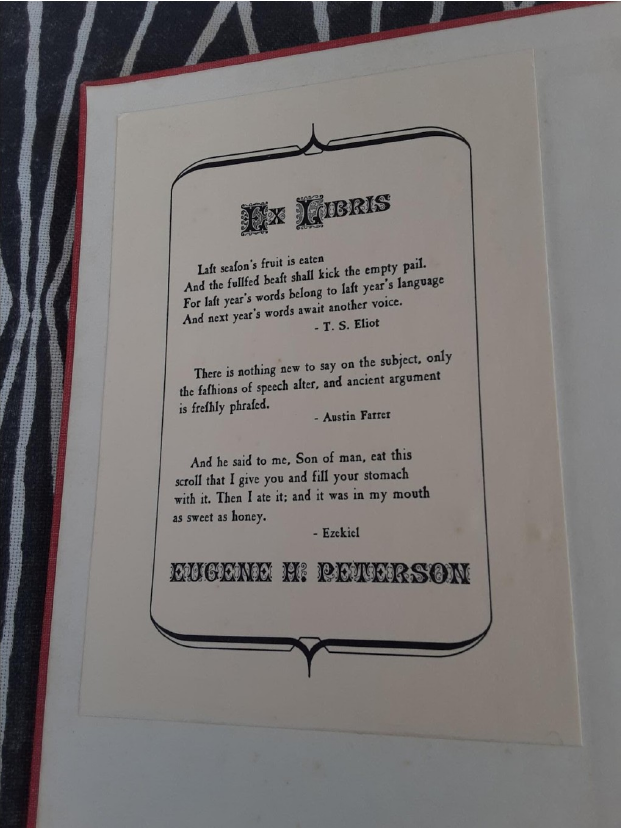
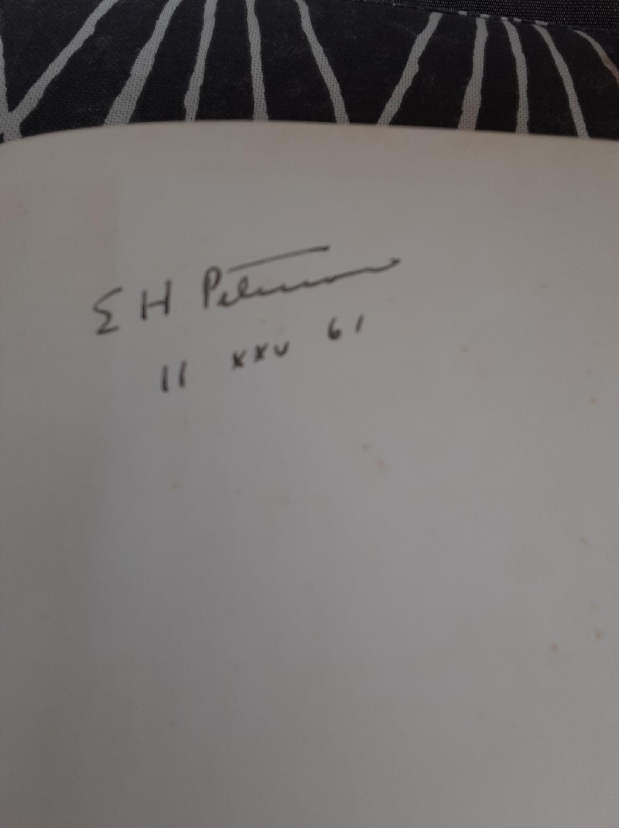
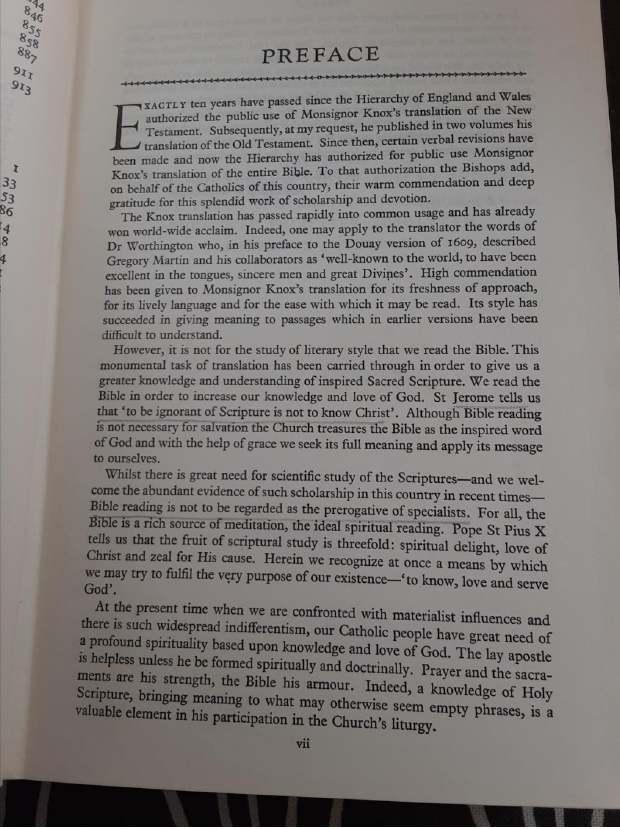
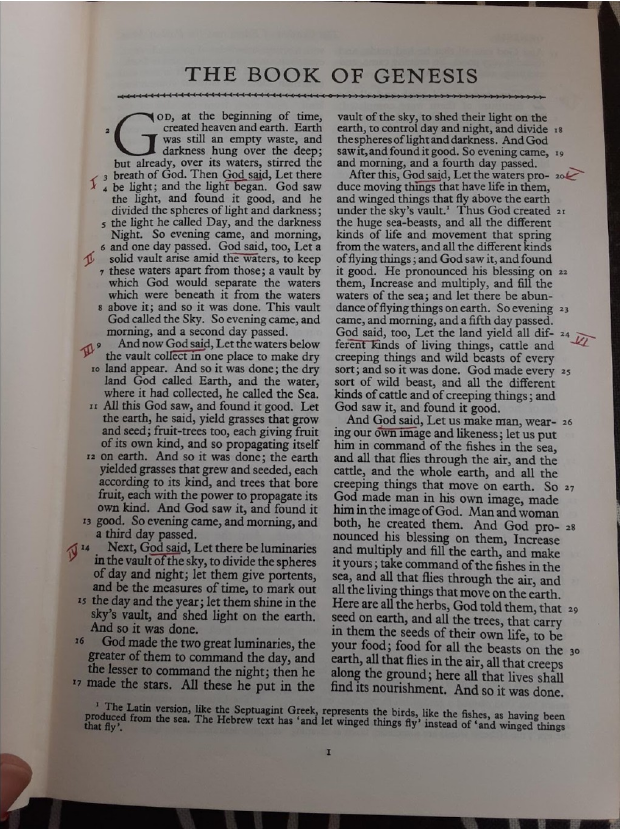
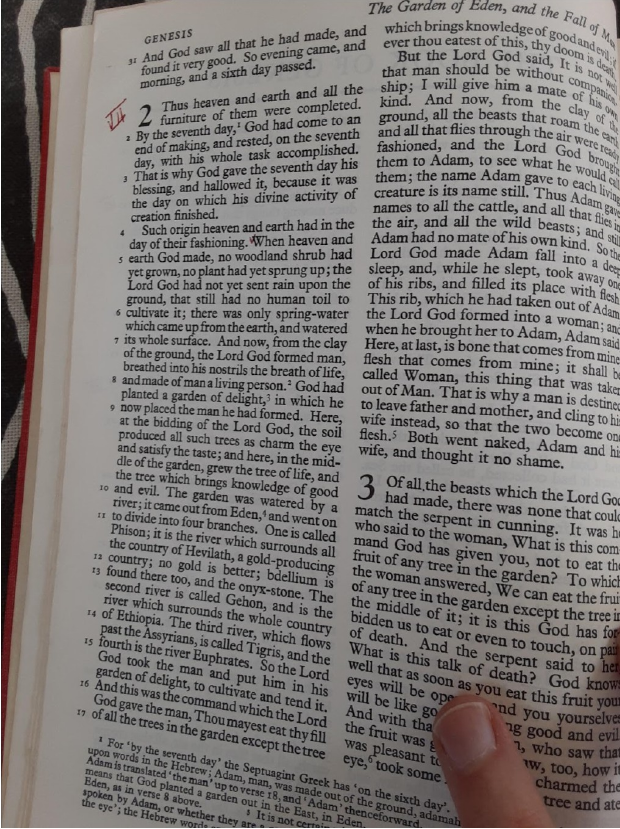
Bob Bob Bob….. man what a treasure you have there. I am jealous, truly. What a gift and thank you so much for sharing the photos. I’d have that placed next to my autographed Knox New Testament. I think Peterson and Knox would have been good friends if they had met. Peterson quotes from Knox’s other works, including Enthusiasm. I also know Peterson very much enjoyed Knox’s detective novels as well. What a treasure!
Very cool.
The bold typeface shown in the pictures above is so easy on the eye and a pleasure to read. I just wonder what’s it called. I’ve had a couple of Douay-Rheims bibles from the early 1950s with similar fonts. I have the Baronius Knox but I prefer to read it online on the New Advent website.
Wow! Definitely the Eugene H. Peterson. He loved T.S. Eliot for a time and Farrar is mentioned here:
http://preachersmith.blogspot.com/2006/08/eat-this-book-some-good-quotes.html